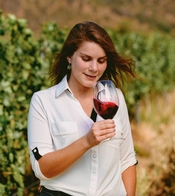Summertime up here in the Northern Hemisphere – Grapes are beginning to look exuberant teenagers, and winegrowers in this top half of the globe are reviewing their summer hedging schedules. Meanwhile, way down South, the 2022 vintage is already over, and the new wines are settling in for their winter’s nap. (I must admit that even though I’ve been writing about wine for a few decades, I still have to go through the finger-calculating exercise of, “OK, if it’s February here, how close are they to harvest in the Southern Hemisphere?”)
It’s also a rite of their winter and our summer that as they put their wines to bed, those whose bottles are marketed and sold across the globe emerge like bright butterflies for their annual migration out into the field, attending wine fairs in the Northern Hemisphere, visiting their importers and distributors and talking with the media about how things turned out this season – just as winemakers from France, Spain and Italy journey to America’s East Coast in December and January to talk about their current vintages.
Which is a long way to getting around to why, on one early day in June, I find myself on a bar stool at Benoit in New York talking with Andrea Calderon, the young, talented, and gregarious chief winemaker for the 1865 brands from the San Pedro winery. Calderon is in town for a walk-around trade tasting of South American wines  nearby this afternoon, as well as for meetings with retailers and wine writers. In celebration, she sips a glass of Champagne while I have a Bloody Mary, and we begin with a discussion of the just-completed harvest.
nearby this afternoon, as well as for meetings with retailers and wine writers. In celebration, she sips a glass of Champagne while I have a Bloody Mary, and we begin with a discussion of the just-completed harvest.
“We started picking Pinot Noir on February 13 in Elqui Valley and didn’t finish harvest until the beginning of May,” she says. “The Pinot Noir is looking very good with lot of fruitiness.” As Chile is a thin strip of coastal land extending roughly 2,700 miles along the Pacific in the southern portion of South America, with more than a dozen primary grape-growing valleys plunging down from the Andes Mountains to the ocean, the almost three months of harvest that Calderon experiences is not unusual, particularly since 1865 makes three lines of wines with grapes sourced from throughout the country.
“We had 10 percent less fruit than we predicted this year,” Calderon says, “because the clusters were smaller, they gave us great color. The fruit also has good persistence on the palate.” The only real downside of 2022, she says, is that there was about 30% less white wine being made than usual, especially less Chardonnay.
Going back in recent vintages, Calderon says that 2020 was a difficult vintage because of drought conditions, somewhat similar to what her California cousins have been experiencing about 6,000 miles to the north. “We had about 40% fewer grapes in 2020, but the quality was pretty good. And the Maipo and Central Valleys did pretty well with Cabernet Sauvignon and Merlot,” Calderon says. “Fortunately, by the time we got to 2021, we had learned to manage drought conditions fairly well, and it was like a more-normal year,” she says. “In 2021, the grapes had a lot of good natural acidity, and we had well-balanced tannins.”
Cabernet Sauvignon is still the wine that sells best internationally from Chile, Calderon says, and her wines have been especially well received in China and South Korea. As far as other Bordeaux grapes are concerned, in addition to Cab and Merlot, she says there isn’t as much interest in Chile in Cabernet Franc as there is in the Northern climes “because of its green notes.” Besides, she says, Carmenère, an emerging Chilean favorite, already fits that profile.
Calderon considers herself fortunate in being able to make wine from so many grapes growing in so many valleys from Elqui in the north to Malleco in the south – although she doesn’t have any vineyards yet in Patagonia. This sourcing versatility, she says, will be reflected in her afternoon walk-around, where she is pouring a Sauvignon Blanc from Leyda, a Cabernet Sauvignon from Maipo, a Carmenère from Maule and an old vines Cabernet from Curico. As her winery, San Pedro, is owned by the VSPT Wine Group, Calderon also gets to make an 1865 brand Malbec from across the mountains in Uco Valley in Argentina.
She says she is especially excited about the once-neglected old vines Cabs. “It’s like we are rescuing them,” she laughs. “There are 11 acres of them in the Lontue Valley region of Curico, and they are a new label for us” she says. “These old plants have learned to balance themselves [without prior irrigation],” Calderon adds. “We use a cold soak, but we give them less barrel times and less new oak – only about 8% – and we’re using some foudres [larger casks] with them.” She is also excited about a limited-edition Syrah from Elqui in the north.
But now it is time for Calderon to go pour wine and for me to have lunch at a nearby table with a Bourgogne producer – not his season, really – having set my palate for drinking elegant Pinot Noirs and whetting my appetite for some Bourgogne food with that bracing Bloody.
68
